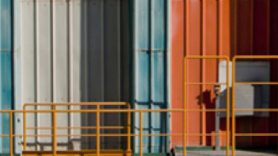As part of the global trend for reducing the environmental impact of cement production, Nesher developed capabilities for the production of cement with low clinker content.
REDUCED-CLINKER CEMENT
As part of the global trend for reducing the environmental impact of cement production, Nesher developed capabilities for the production of cement with low clinker content. The clinker production process, an essential intermediary step in cement production, has the highest environmental impact in the manufacturing process, due to its energy consumption and greenhouse gases emissions. Consequently, the global cement industry is increasingly looking for various technological solutions for using cement with low clinker content. In the last few years we have witnessed a growing demand for cement with reduced clinker content, and a corresponding growth in the demand for the variety of products and the volume of cement with reduced clinker content produced by Nesher.
Slag cement is a unique type of cement with low clinker content. This type of cement is characterized by a low clinker content – only 30% – compared with standard cement (which contains 80% clinker). This unique type of cement, which contains slag, a by-product of the steel industry, provides solutions for building in marine environments and extreme conditions. Concrete produced from this type of cement is highly resistant for long periods of time, with high durability even in extreme conditions such as wastewater infrastructures.
Nesher’s goal as a cement producer is to ensure that the customer makes optimal use of its product by choosing the type of cement most suited to their specific project requirements. Nesher works in close collaboration with its customers to achieve maximum efficiency of use. This entails a joint learning process in the laboratory as well as in the field, in an effort to explain the properties of concrete made from the different types of cement. Laboratory tests are conducted to obtain required concrete properties at lower costs for the customer, and to check the chemical additives in the concrete (in addition to the cement) in order to create the optimal concrete mix for the customer’s needs, taking into account both properties and cost.
Nesher’s experts provide professional support for customers’ projects, from the laboratory to field tests, to ensure a good fit. Global trends and the customer demand call for high quality, durable cement with lower clinker content, and Nesher does indeed deliver this to its customers and facilitates their transition from clinker-rich cement to reduced-clinker cement.
ENVIRONMENTAL PRODUCT DECLARATION
Environmental Awareness throughout the stages of production is growing among both manufacturers and consumers.
The Life Cycle Assessment (LCA) is a tool for assessing environmental impacts of products and materials. This analytical method includes gathering and assessment of input, output and the potential environmental impacts during all stages of the product’s life cycle, from raw material excavation and production to product use and finally to its end-of-life. Life Cycle Assessment is a useful tool for making informed decisions with regard to new product development and optimization of energy and raw material consumption. It also helps to identify solutions for reducing greenhouse gas emissions, finding alternatives to harmful materials, and comparing between environmental impacts of different products. Information obtained from LCA can also influence environmental policies and regulations.
In order to facilitate an evaluation of the environmental impacts and to compare between the environmental impact of different products, a new discipline named Environmental Product Declaration (EPD) has emerged. The EPD for a product is a single document summarizing the entire range of environmental impacts of the product throughout its lifecycle, based on an LCA conducted according to industry-specific instructions. Registration in the Intenational EPD requires auditing by an independent external entity.
The EPD is public domain and enables review of product environmental impacts. EDP reports contain information on the carbon footprint and the product’s impact on global warming, ozone depletion, acidification for soil and water, eutrophication, photochemical ozone creation, depletion of abiotic resources (elements and fossil fuels). As more EPDs for different products become available, this allows for a comparison between products with regard to environmental impacts.
The construction industry has readily embraced the environmental reporting approach for its products, especially with regard to green building. This approach is being advocated by international bodies, such as the UK Green Building Council – which is promoting the standards of the BREEAM (Building Research Establishment Environmental Assessment Method), and the US Green Building Council (USGBC), which supervises the LEED green building rating methods.
Nesher has conducted LCA for its three main products (cement types), which have been validated by an external body and registered in the international EPD registry. Nesher is the first Israeli company to register its products in the international registry.
http://www.environdec.com/en/News-archive/Nesher-registers-the-first-EPD-from-Israel
EPD for Nesher products
http://www.environdec.com/en/Detail/?Epd=9796#.U5AwH_m4W3g
http://www.environdec.com/en/Detail/?Epd=9798#.U5AwRvm4W3g
http://www.environdec.com/en/Detail/?Epd=9799#.U5AwVPm4W3g
THE GREEN LABEL
The majority of Nesher’s products have been awarded the Green Label (with the exception of CEM-I cement which, due to strength requirements, has a high clinker content.) A Green Lable is jointly awarded by the Israel Standards Institution and the Ministry of Environmental Protection to products and services with reduced environmental impacts.
Green building places an emphasis on energy conservation while adapting to the local climate, waste prevention and recycling, and reducing environmental impacts during construction. It also emphasizes the prevention of water, soil and air pollution, as well as prevention of physical damage to the local environment.
When it comes to green building, cement and concrete have several advantages, including: light-colored concrete surfaces with a higher albedo than asphalt surfaces allow reduction of the urban heat island; porous concrete allows water to permeate to the ground and reduces the need for large drainage and sewage systems;
Cement production allows the utilization of recycled raw materials and alternative fuels (waste and by-products from various industries. Concrete, due to its long life cycle, high thermal mass and low latent energy, is an energetically and environmentally efficient construction material.



